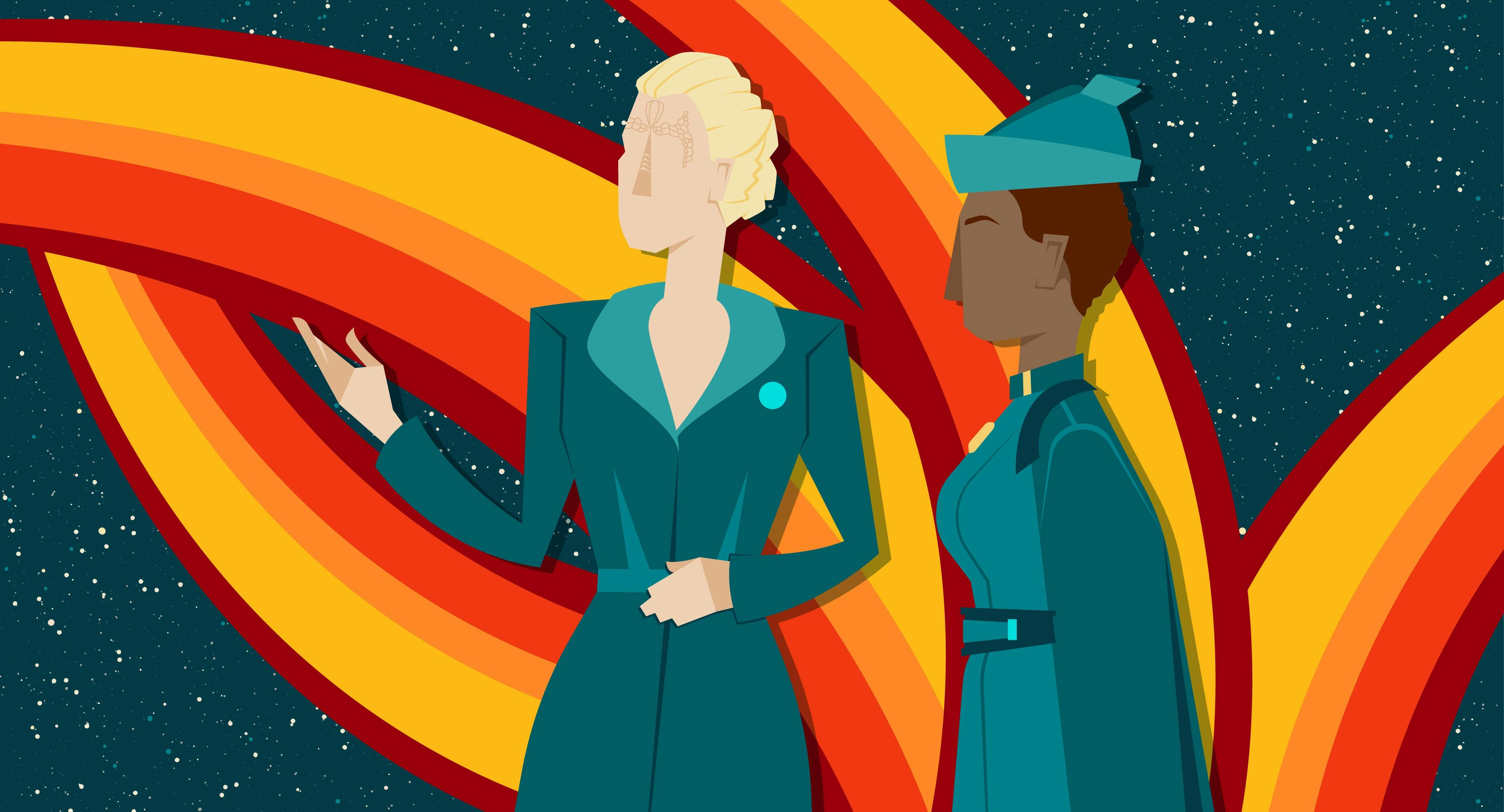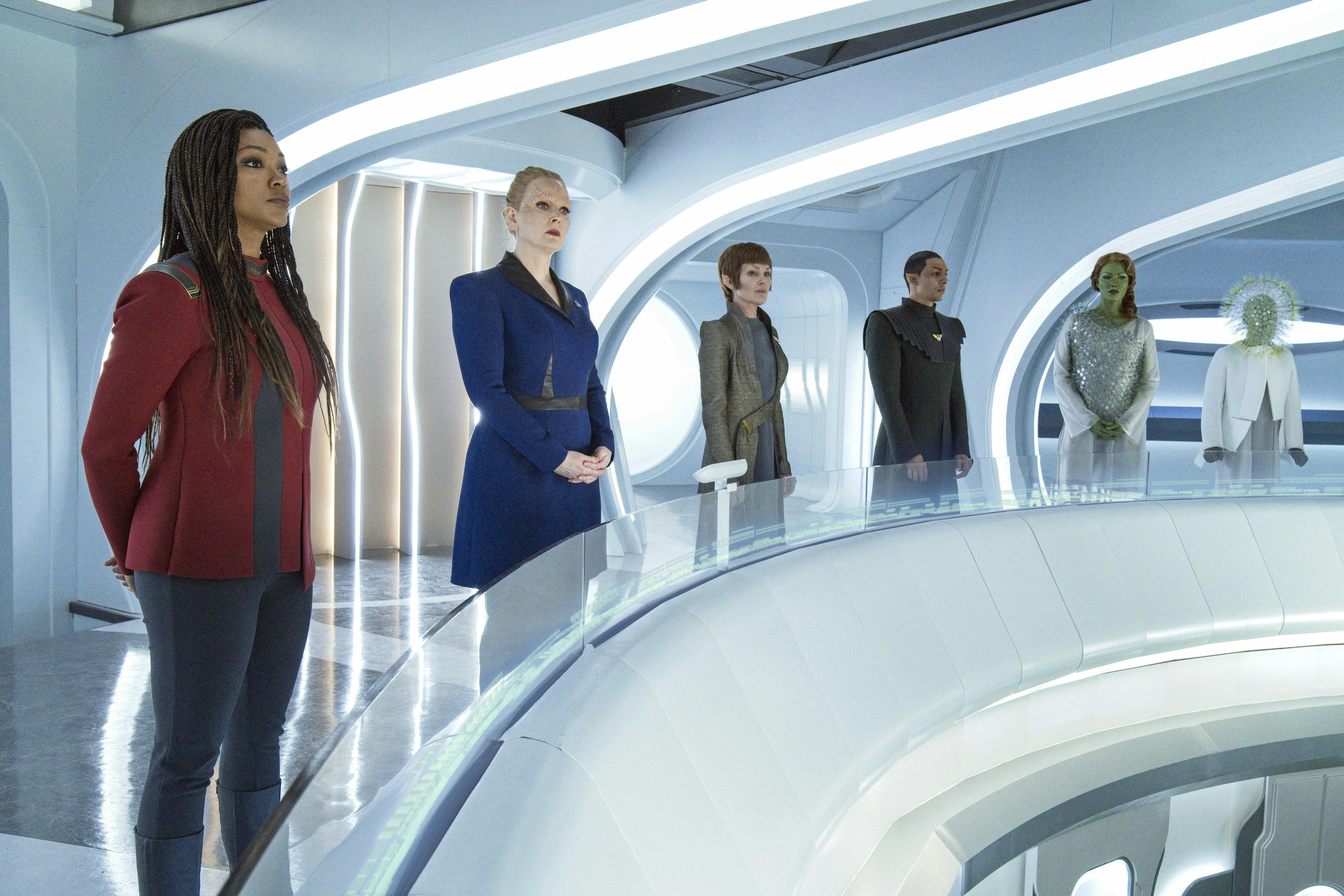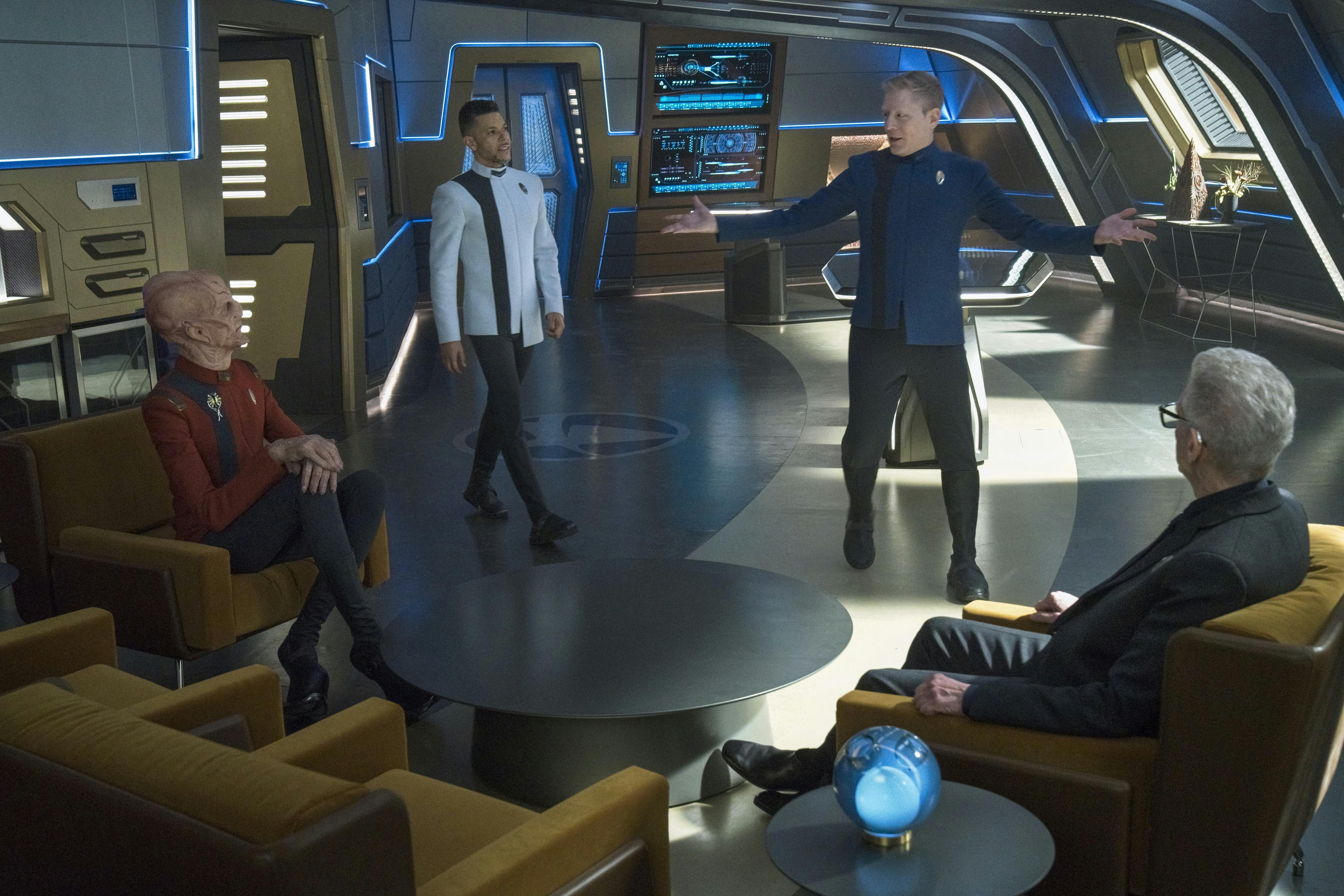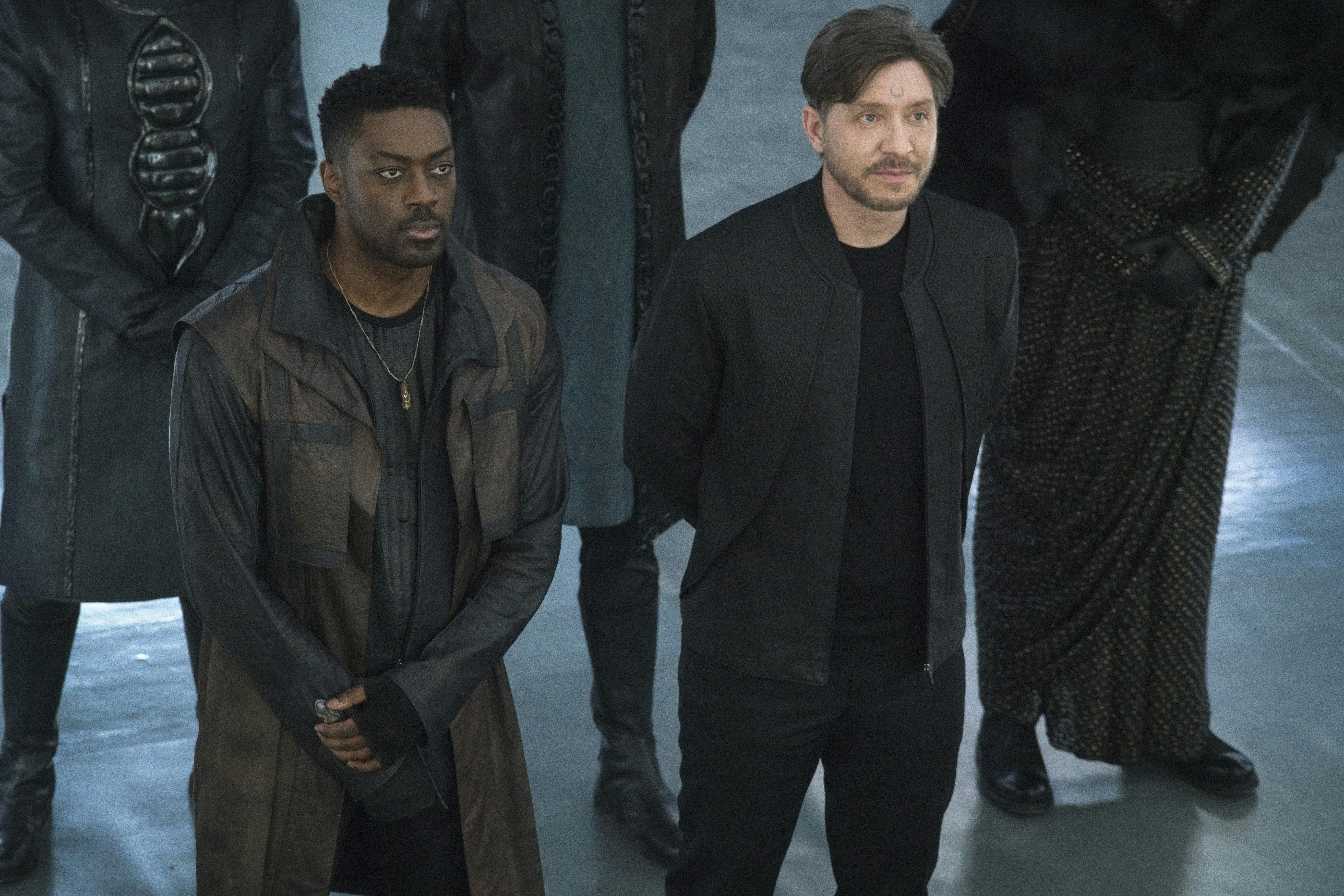Published Dec 31, 2021
Recap: Star Trek: Discovery - ...But To Connect
The mid-season finale leaves us waiting for more...

StarTrek.com
This article contains spoilers for Star Trek: Discovery season four, episode seven.
With the U.S.S. Discovery-A still undergoing repairs as a result of its mission to the subspace rift, Paul Stamets and Adira Tal analyze the data from the energy particles that the Dark Matter Anomaly (DMA) left behind when it traversed the galactic barrier and entered our galaxy. Zora calculates the coordinates for Species 10-C, the name Starfleet assigned to the DMA’s elusive creators, but refuses to divulge the information in an effort to protect the crew from danger.
Zora denies Captain Burnham’s order to share the location, prompting a visit from Doctor Kovich, who explains that he must evaluate Zora, as Starfleet prohibits fully sentient artificial intelligences from being integrated into its vessels. Interestingly, when Kovich utilizes his tricom badge, we get a look at the device in privacy mode, a nifty feature which conceals everything he’s accessing on the holographic interface.
As Federation President Rillak hosts an assembly that includes representatives from all four quadrants (the galaxy feels so much cozier in the 32nd century!), we are reintroduced to General Ndoye of the United Earth Defense Force, previously seen in season three’s “People of Earth.” We learn that Titan has become part of Earth’s jurisdiction once again, and Rillak expresses a hope that the former member will consider rejoining the Federation.

StarTrek.com
The impressive gathering brings together numerous species, ranging from familiar faces (Orion, Ni’Var, Ferengi, Cardassian, Andorian) to more recent reveals (the Alshain from “Kobayashi Maru” and a new race with ram-like horns). Rillak addresses the delegates, believing that they must decide on how to deal with Species 10-C. Ndoye proposes forming an armada, while T’Rina of Ni’Var suggests a diplomatic approach. Burnham cites voles who eat Denobulan bloodworms as an example of a species that causes destruction without malice (Doctor Phlox would love this reference!), implying that Species 10-C may not hold hostile intent.
Aboard Discovery, Kovich meets with Saru, Stamets, Culber, and Zora to work through the issue of the artificial intelligence’s sentience. Stamets emphasizes his displeasure with Zora’s emotional display, while Kovich states that the astromycologist’s views might be influenced by the 23rd century fight against Control. Zora hypothesizes that her capacity for emotion was inevitable once the starship merged with the Sphere data (another plot thread traced back to season two). Zora proposes a compromise: a failsafe device that would allow Discovery’s crew to terminate her if they ever felt she had become a threat.
At Rillak’s assembly, Ruon Tarka chimes in to encourage the delegates to destroy the DMA with a new weapon he designed based on the research he conducted in “The Examples.” The device is an isolytic weapon, a technology banned by the Khitomer Accords and previously employed by the Son’a in Star Trek: Insurrection. Burnham points out that the subspace burst could travel back through the DMA’s wormhole and be seen as an act-of-war by Species 10-C.
During a recess, Book argues that action must be taken against the DMA, mentioning Burnham’s own insubordinate attempt to attack the Klingons in “The Vulcan Hello” as a precedent. The captain prefers diplomacy, a position supported by Rillak. In a private conversation with Book, Tarka shockingly admits that he wishes to use the DMA controller’s power source to travel to a parallel universe where The Burn never occurred. Tarka plans to move there and reunite with another scientist who had also been imprisoned by Osyraa, the former Emerald Chain leader who was killed in the season three finale.

StarTrek.com
Adira and Gray join Kovich’s mini-summit to defend Zora’s rights, where the group learns that Zora is responsible for providing her own core programming: to care for the crew of Discovery. While examining Zora’s systems, the crew finds a sector containing various images (Discovery’s rendezvous with the Sphere, its trip into the future, and tender moments with the crew among them) that reveal Zora’s subconscious values love and connection… that’s right, Zora is an entirely new lifeform!
Following Book’s impassioned plea in support of Tarka’s weapon on behalf of all those who had been killed by the DMA, Burnham urges the delegates to work toward the future they wish to see rather than be guided by fear. The representatives are swayed by the captain’s words, with the majority voting for a peaceful approach.
At the same time, Stamets explains to Zora that trust must go both ways, causing Zora to reevaluate her position and provide Species 10-C’s coordinates. Kovich concludes his evaluation by determining that Zora is a new lifeform, resulting in a beautiful moment where the A.I. truly feels ‘seen’ (a breakthrough that every member of a marginalized community deserves to experience). The astromycologist then recommends that Zora officially join Starfleet. Kovich explains that, had Stamets held on to his misgivings, the doctor would have reassigned him rather than extract Zora from Discovery.
In a stunning move, Tarka steals the next generation spore drive he had developed with Aurellio and installs it into Book’s ship. Having left a love note for Michael and transported Grudge to the captain’s quarters, Book pilots his vessel out of Discovery’s shuttle bay and, along with the Risan scientist, makes an unsanctioned jump to parts unknown.

StarTrek.com
As its title implies, “...But To Connect” highlights the benefits of forging relationships and investing one’s trust in others. Stamets changing his mind about Zora, Adira supporting Gray’s last-minute decision to study on Trill, and Saru gifting T’Rina with a Kelpien flower each showcase the power of connection. On the other hand, the rift that sprouts between Burnham and Book, which had been foreshadowed by Book’s father in “Stormy Weather,” underlines the fact that even the sturdiest bonds can be tested. With Zora becoming the first of her species in Starfleet (Worf and Nog would surely be proud) and Book jumping away with Tarka, the rest of the season promises to continue to be a thrilling ride. Stay tuned as we continue to boldly go…
Jay Stobie (he/him) is a freelance writer and consultant who has contributed articles to StarTrek.com, Star Trek Explorer, and Star Trek Magazine, as well as to Star Wars Insider and StarWars.com. Jay serves as a BoldlyGo Campaign Ambassador for The Roddenberry Foundation. Jay can be found on Twitter and Instagram at @StobiesGalaxy.
Star Trek: Discovery currently streams exclusively on Paramount+ in the U.S. Internationally, the series is available on Paramount+ in Australia, Latin America and the Nordics, and on Pluto TV in Austria, France, Germany, Italy, Spain, Switzerland and the United Kingdom on the Pluto TV Sci-Fi channel. In Canada, it airs on Bell Media’s CTV Sci-Fi Channel and streams on Crave. Star Trek: Discovery is distributed by ViacomCBS Global Distribution Group.

